Abstract
X-linked retinitis pigmentosa (XLRP) is a severe form of inherited progressive retinal degeneration. The RP3 (retinitis pigmentosa type 3) locus at Xp21.1 is believed to account for the disease in the majority of XLRP families. Linkage analysis and identification of patients with chromosomal deletion have refined the location of the RP3 locus and recently have led to the cloning of the RPGR (retinitis pigmentosa GTPase regulator) gene, which has been shown to be mutated in 10%-15% of XLRP patients. In order to systematically characterize the RPGR mutations, we identified 11 retinitis pigmentosa type III (RP3) families by haplotype analysis. Sequence analysis of the PCR-amplified genomic DNA from patients representing these RP3 families did not reveal any causative mutation in RPGR exons 2-19, spanning >98% of the coding region. In patients from two families, we identified transition mutations in the intron region near splice sites (IVS10+3 and IVS13-8). RNA analysis showed that both splice-site mutations resulted in the generation of aberrant RPGR transcripts. Our results support the hypothesis that mutations in the reported RPGR gene are not a common defect in the RP3 subtype of XLRP and that a majority of causative mutations may reside either in as yet unidentified RPGR exons or in another nearby gene at Xp21.1.
Full text
PDF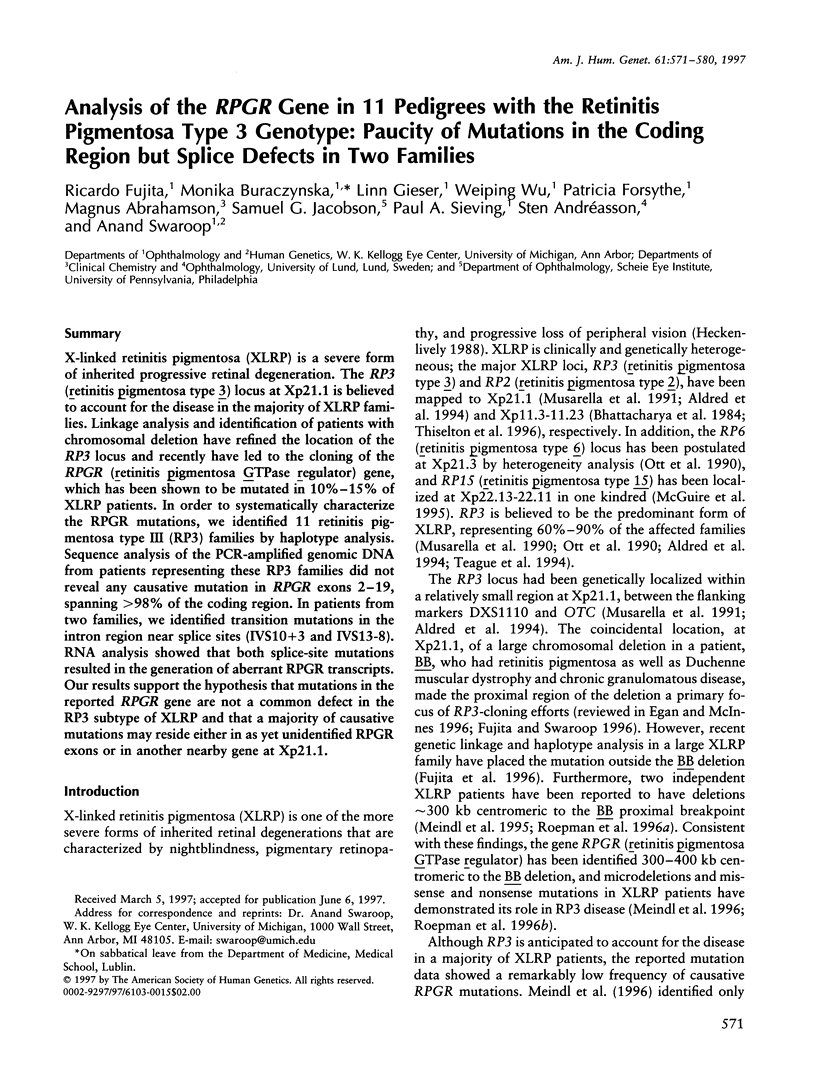
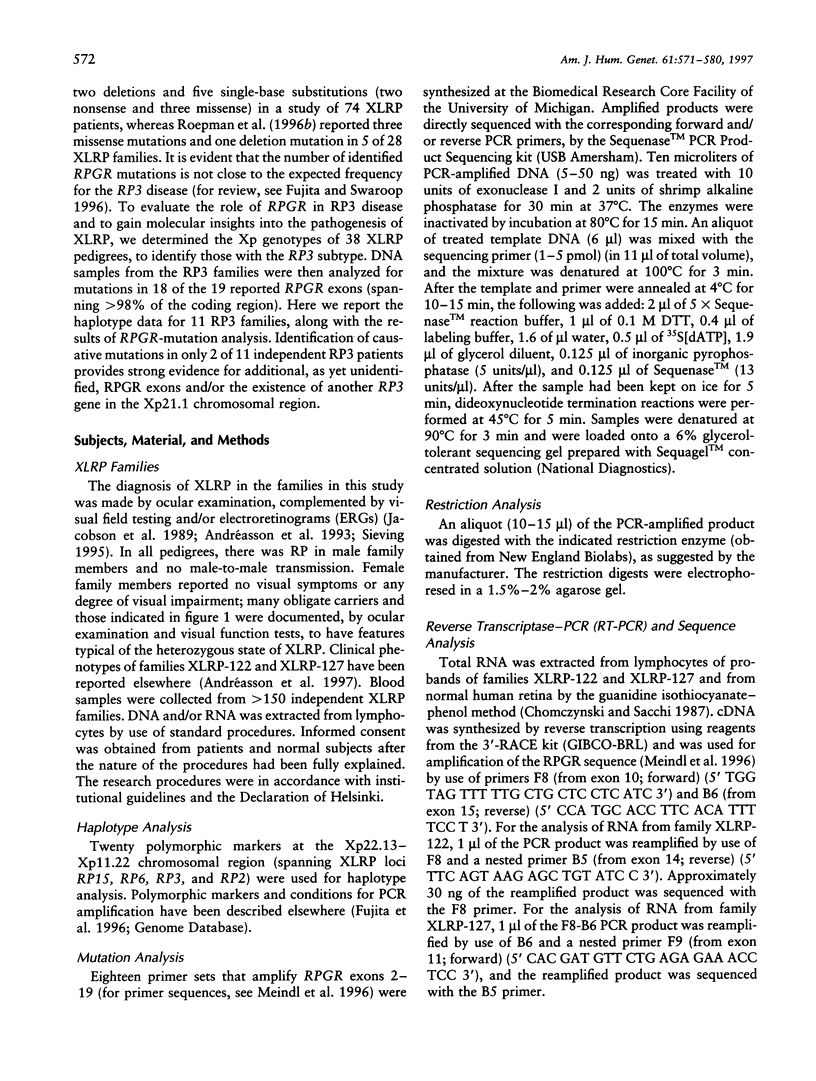
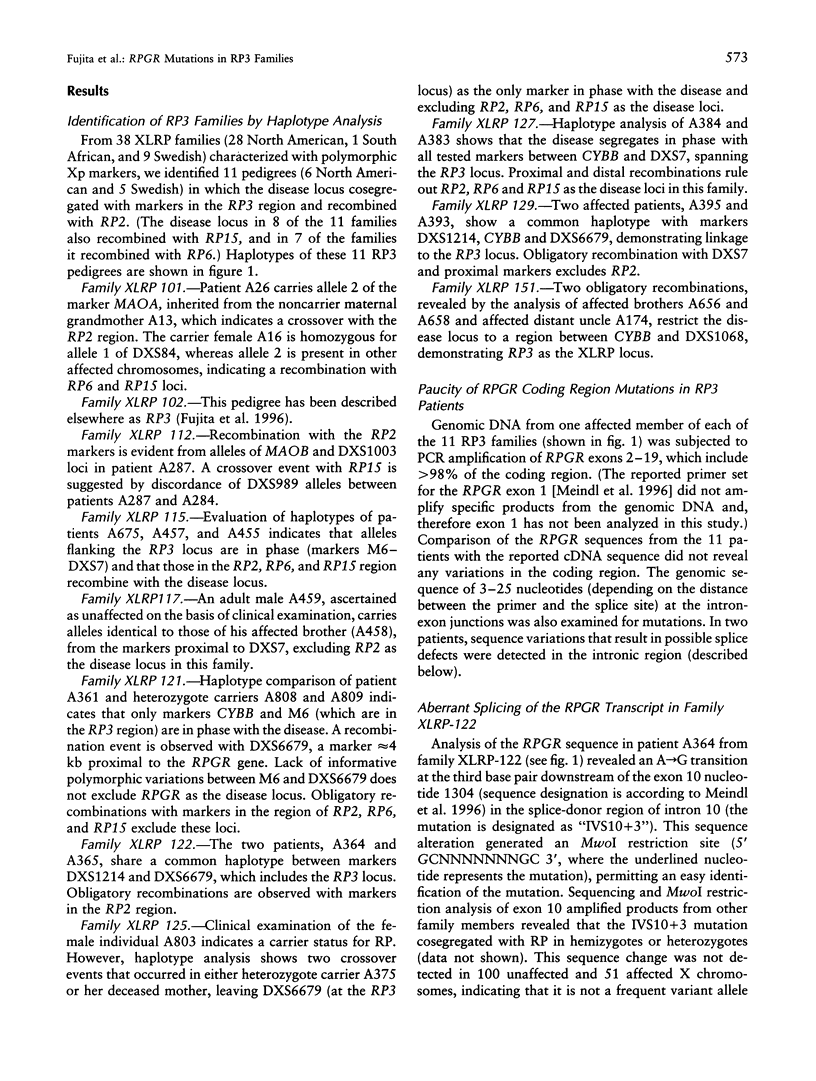
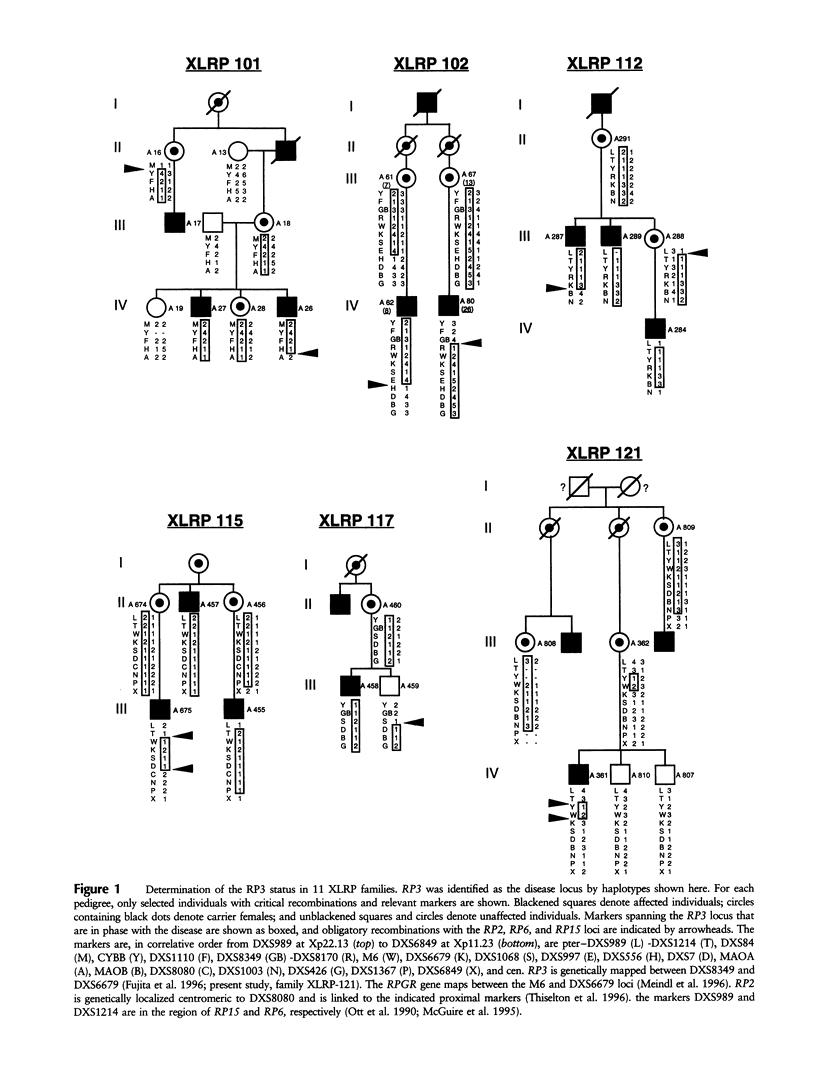
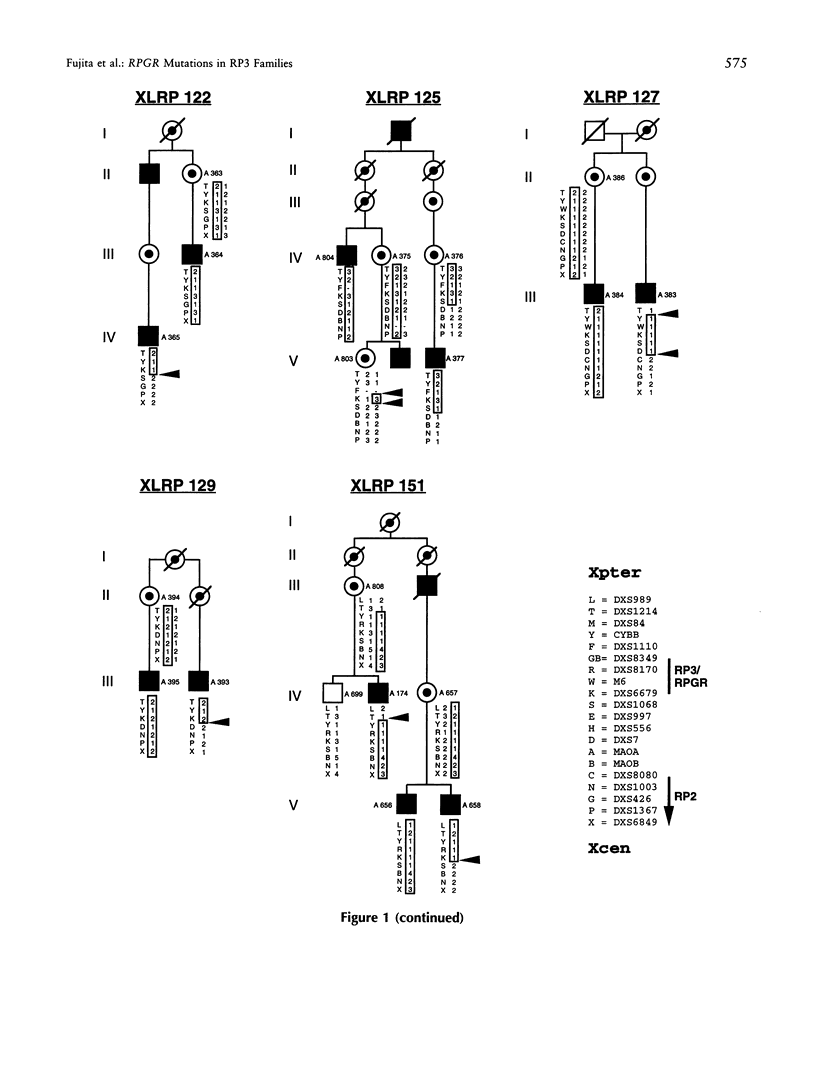
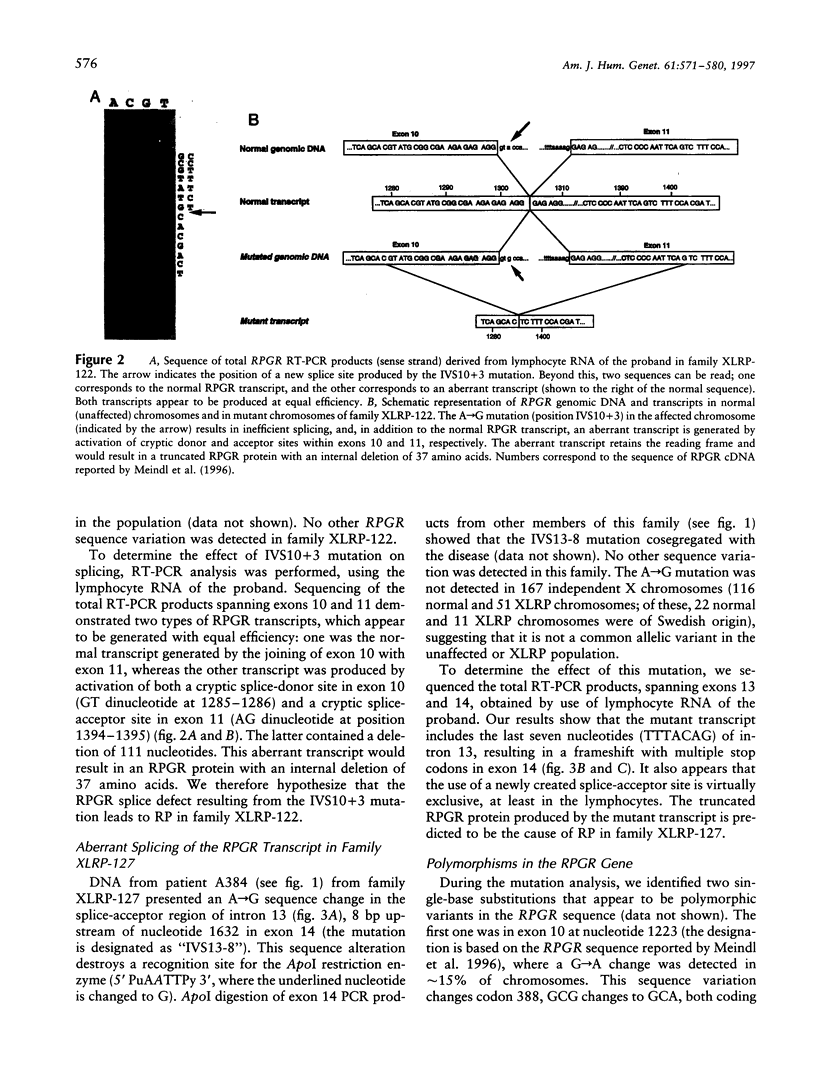
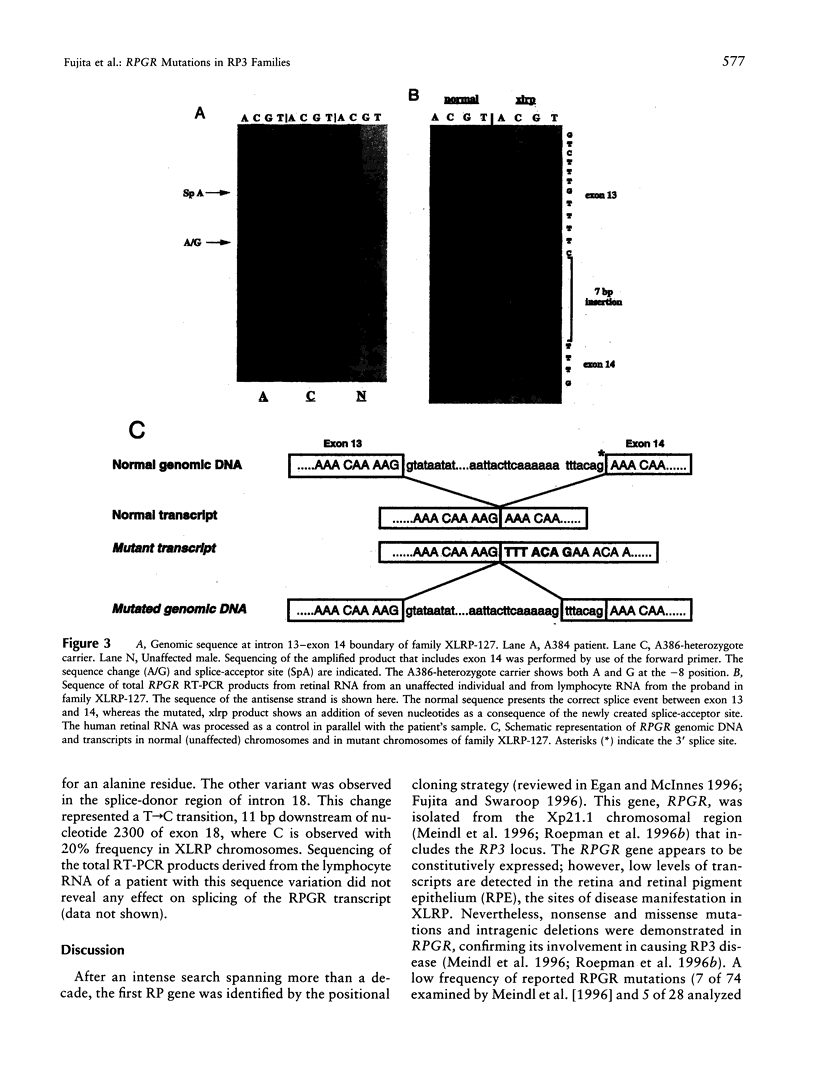

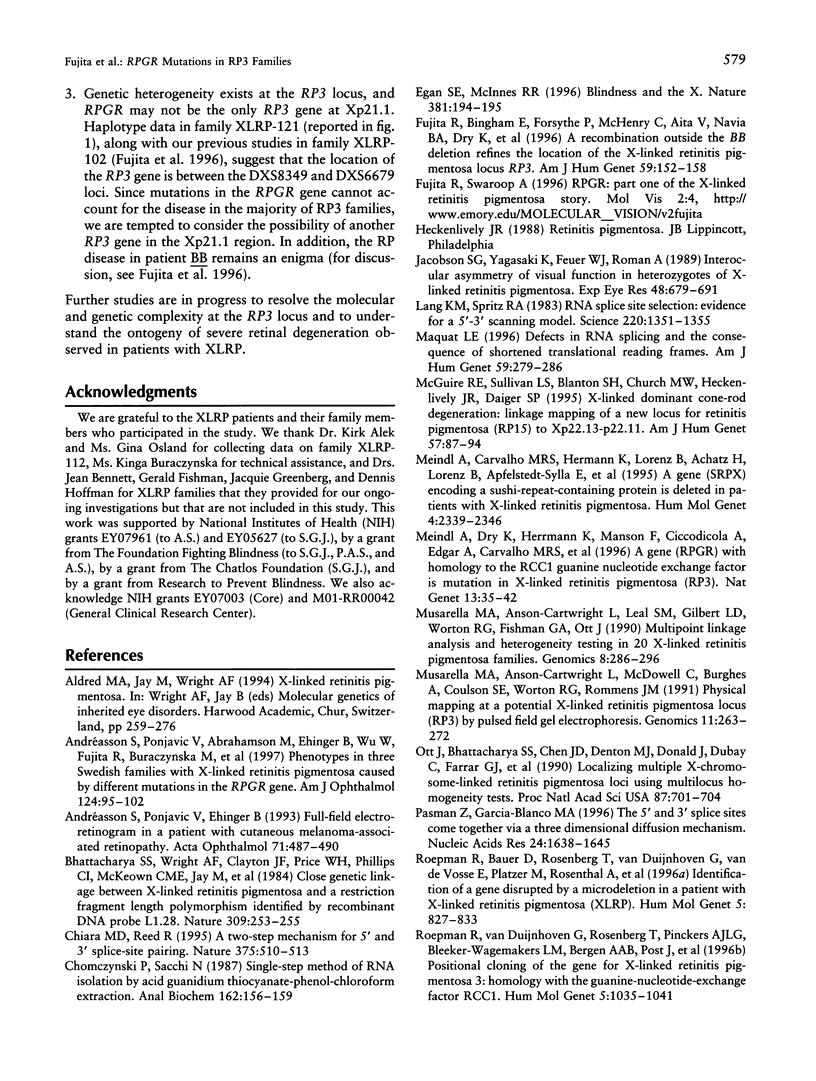

Images in this article
Selected References
These references are in PubMed. This may not be the complete list of references from this article.
- Andréasson S., Ponjavic V., Abrahamson M., Ehinger B., Wu W., Fujita R., Buraczynska M., Swaroop A. Phenotypes in three Swedish families with X-linked retinitis pigmentosa caused by different mutations in the RPGR gene. Am J Ophthalmol. 1997 Jul;124(1):95–102. doi: 10.1016/s0002-9394(14)71649-6. [DOI] [PubMed] [Google Scholar]
- Andréasson S., Ponjavic V., Ehinger B. Full-field electroretinogram in a patient with cutaneous melanoma-associated retinopathy. Acta Ophthalmol (Copenh) 1993 Aug;71(4):487–490. doi: 10.1111/j.1755-3768.1993.tb04623.x. [DOI] [PubMed] [Google Scholar]
- Bhattacharya S. S., Wright A. F., Clayton J. F., Price W. H., Phillips C. I., McKeown C. M., Jay M., Bird A. C., Pearson P. L., Southern E. M. Close genetic linkage between X-linked retinitis pigmentosa and a restriction fragment length polymorphism identified by recombinant DNA probe L1.28. Nature. 1984 May 17;309(5965):253–255. doi: 10.1038/309253a0. [DOI] [PubMed] [Google Scholar]
- Chiara M. D., Reed R. A two-step mechanism for 5' and 3' splice-site pairing. Nature. 1995 Jun 8;375(6531):510–513. doi: 10.1038/375510a0. [DOI] [PubMed] [Google Scholar]
- Chomczynski P., Sacchi N. Single-step method of RNA isolation by acid guanidinium thiocyanate-phenol-chloroform extraction. Anal Biochem. 1987 Apr;162(1):156–159. doi: 10.1006/abio.1987.9999. [DOI] [PubMed] [Google Scholar]
- Egan S. E., McInnes R. R. Human genetics. Blindness and the X. Nature. 1996 May 16;381(6579):194–195. doi: 10.1038/381194a0. [DOI] [PubMed] [Google Scholar]
- Fujita R., Bingham E., Forsythe P., McHenry C., Aita V., Navia B. A., Dry K., Segal M., Devoto M., Bruns G. A recombination outside the BB deletion refines the location of the X linked retinitis pigmentosa locus RP3. Am J Hum Genet. 1996 Jul;59(1):152–158. [PMC free article] [PubMed] [Google Scholar]
- Lang K. M., Spritz R. A. RNA splice site selection: evidence for a 5' leads to 3' scanning model. Science. 1983 Jun 24;220(4604):1351–1355. doi: 10.1126/science.6304877. [DOI] [PubMed] [Google Scholar]
- Maquat L. E. Defects in RNA splicing and the consequence of shortened translational reading frames. Am J Hum Genet. 1996 Aug;59(2):279–286. [PMC free article] [PubMed] [Google Scholar]
- McGuire R. E., Sullivan L. S., Blanton S. H., Church M. W., Heckenlively J. R., Daiger S. P. X-linked dominant cone-rod degeneration: linkage mapping of a new locus for retinitis pigmentosa (RP 15) to Xp22.13-p22.11. Am J Hum Genet. 1995 Jul;57(1):87–94. [PMC free article] [PubMed] [Google Scholar]
- Meindl A., Carvalho M. R., Herrmann K., Lorenz B., Achatz H., Lorenz B., Apfelstedt-Sylla E., Wittwer B., Ross M., Meitinger T. A gene (SRPX) encoding a sushi-repeat-containing protein is deleted in patients with X-linked retinitis pigmentosa. Hum Mol Genet. 1995 Dec;4(12):2339–2346. doi: 10.1093/hmg/4.12.2339. [DOI] [PubMed] [Google Scholar]
- Meindl A., Dry K., Herrmann K., Manson F., Ciccodicola A., Edgar A., Carvalho M. R., Achatz H., Hellebrand H., Lennon A. A gene (RPGR) with homology to the RCC1 guanine nucleotide exchange factor is mutated in X-linked retinitis pigmentosa (RP3). Nat Genet. 1996 May;13(1):35–42. doi: 10.1038/ng0596-35. [DOI] [PubMed] [Google Scholar]
- Musarella M. A., Anson-Cartwright C. L., McDowell C., Burghes A. H., Coulson S. E., Worton R. G., Rommens J. M. Physical mapping at a potential X-linked retinitis pigmentosa locus (RP3) by pulsed-field gel electrophoresis. Genomics. 1991 Oct;11(2):263–272. doi: 10.1016/0888-7543(91)90132-x. [DOI] [PubMed] [Google Scholar]
- Musarella M. A., Anson-Cartwright L., Leal S. M., Gilbert L. D., Worton R. G., Fishman G. A., Ott J. Multipoint linkage analysis and heterogeneity testing in 20 X-linked retinitis pigmentosa families. Genomics. 1990 Oct;8(2):286–296. doi: 10.1016/0888-7543(90)90284-2. [DOI] [PMC free article] [PubMed] [Google Scholar]
- Ott J., Bhattacharya S., Chen J. D., Denton M. J., Donald J., Dubay C., Farrar G. J., Fishman G. A., Frey D., Gal A. Localizing multiple X chromosome-linked retinitis pigmentosa loci using multilocus homogeneity tests. Proc Natl Acad Sci U S A. 1990 Jan;87(2):701–704. doi: 10.1073/pnas.87.2.701. [DOI] [PMC free article] [PubMed] [Google Scholar]
- Pasman Z., Garcia-Blanco M. A. The 5' and 3' splice sites come together via a three dimensional diffusion mechanism. Nucleic Acids Res. 1996 May 1;24(9):1638–1645. doi: 10.1093/nar/24.9.1638. [DOI] [PMC free article] [PubMed] [Google Scholar]
- Roepman R., Bauer D., Rosenberg T., van Duijnhoven G., van de Vosse E., Platzer M., Rosenthal A., Ropers H. H., Cremers F. P., Berger W. Identification of a gene disrupted by a microdeletion in a patient with X-linked retinitis pigmentosa (XLRP). Hum Mol Genet. 1996 Jun;5(6):827–833. doi: 10.1093/hmg/5.6.827. [DOI] [PubMed] [Google Scholar]
- Roepman R., van Duijnhoven G., Rosenberg T., Pinckers A. J., Bleeker-Wagemakers L. M., Bergen A. A., Post J., Beck A., Reinhardt R., Ropers H. H. Positional cloning of the gene for X-linked retinitis pigmentosa 3: homology with the guanine-nucleotide-exchange factor RCC1. Hum Mol Genet. 1996 Jul;5(7):1035–1041. doi: 10.1093/hmg/5.7.1035. [DOI] [PubMed] [Google Scholar]
- Sieving P. A. Diagnostic issues with inherited retinal and macular dystrophies. Semin Ophthalmol. 1995 Dec;10(4):279–294. doi: 10.3109/08820539509063799. [DOI] [PubMed] [Google Scholar]
- Smith C. W., Chu T. T., Nadal-Ginard B. Scanning and competition between AGs are involved in 3' splice site selection in mammalian introns. Mol Cell Biol. 1993 Aug;13(8):4939–4952. doi: 10.1128/mcb.13.8.4939. [DOI] [PMC free article] [PubMed] [Google Scholar]
- Teague P. W., Aldred M. A., Jay M., Dempster M., Harrison C., Carothers A. D., Hardwick L. J., Evans H. J., Strain L., Brock D. J. Heterogeneity analysis in 40 X-linked retinitis pigmentosa families. Am J Hum Genet. 1994 Jul;55(1):105–111. [PMC free article] [PubMed] [Google Scholar]
- Thiselton D. L., Hampson R. M., Nayudu M., Van Maldergem L., Wolf M. L., Saha B. K., Bhattacharya S. S., Hardcastle A. J. Mapping the RP2 locus for X-linked retinitis pigmentosa on proximal Xp: a genetically defined 5-cM critical region and exclusion of candidate genes by physical mapping. Genome Res. 1996 Nov;6(11):1093–1102. doi: 10.1101/gr.6.11.1093. [DOI] [PubMed] [Google Scholar]




